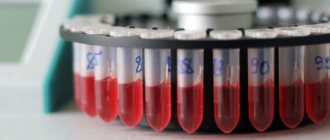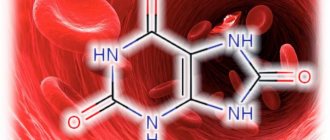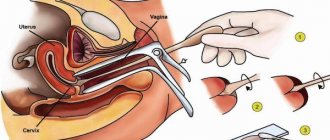What is diastase in urine
Diastase (alpha-amylase) is an enzyme, or rather, a mixture of them, involved in the body’s processing of complex carbohydrates. Its main function is to break polysaccharides into small particles.
The production of the substance is stimulated by food intake. Diastasis is produced by the pancreas, salivary glands, as well as the reproductive organs and intestines. Initially, it penetrates the digestive system, after which it is absorbed into the blood and excreted in the urine.
What does the diastase analysis show:
- pancreatic diseases;
- disruptions in the endocrine system;
- kidney pathologies.
A urine test is prescribed for complaints of a bluish tint to the face, the urge to vomit, pain in the solar plexus, rumbling in the stomach and flatulence. Determining how many units per liter of this enzyme are present in the urine is necessary to identify the cause of unpleasant symptoms.
Deviation from the norm in any direction is always bad. With amylase deficiency, food is poorly digested, and with excess, poisoning is possible.
When is the test scheduled?
A blood test helps assess the condition of the body. Amylase - what is it, under what diseases does it increase in the blood? The level of alpha-amylase in blood plasma can increase several times in the following pathologies:
- Acute or chronic pancreatitis during exacerbation.
- Pancreatic necrosis is focal.
- Pancreatic oncology.
- Gallstone disease (in the presence of individual stones in the ductal system).
- Acute appendicitis.
- Kidney failure.
- Stomach bleeding.
- Intestinal obstruction.
- Alcoholism and alcohol intoxication.
- AIDS.
- Viral hepatitis.
- Mumps.
- Sarcoidosis.
- Typhoid fever.
- Abdominal (upper) injuries.
The level of alpha-amylase is reduced or not detected at all in cases of total necrosis of the pancreas, with stage 4 oncology of this organ, because gland tissue is replaced by tumor tissue, as well as cystic fibrosis (congenital pathology). During surgical interventions, when a significant part of the gland is removed, the level of amylase can also be sharply reduced.
How to get tested for diastasis correctly
Urine collection for diastasis should be carried out in a clean container purchased from a pharmacy. If there is none, you are allowed to use any other container. However, it is important to wash it with soda and pour boiling water over it. Before collecting biological fluid, you should toilet the genitals. Women need to cover the external opening of the vagina with a cotton swab.
To determine the level of diastase, 50 ml of urine is enough. Therefore, there is no need to bring the entire portion to the laboratory.
The urine collection algorithm directly depends on what type of study the specialist prescribed:
- For a 24-hour test, it is necessary to collect urine throughout the day (only the first, morning urination is excluded). The material must be stored at low temperatures. To maintain diastase activity, a special preservative is added to the urine. During collection, it is necessary to consume a sufficient amount of liquid.
- For the 2-hour test, urine is collected for two hours. This can be done at any time of the day, but it is better to choose the morning to perform the manipulations. 2 hours before collecting biomaterial, fluid intake should be limited. You should eat no later than 2 hours before urinating.
The prepared urine sample should be taken to the laboratory as soon as possible.
Collection and delivery of urine
- Urine must be collected in the morning, and the container in which it is transferred to a medical facility must be sterilely clean. To collect, you can use a regular glass jar, previously washed with soda and dried.
- Doctors usually recommend donating warm urine and collecting it directly at the collection point. But experts may give other recommendations, suggesting that urine should be cold, in which case it can be collected at home. In addition, in some cases, collecting urine for analysis for diastase may be indicated not in the morning, but at another time of the day.
- As for the amount of urine required for analysis, only a few ml of urine is enough. The main thing is that it is collected correctly and sent to the laboratory in a timely manner. The last condition must be met due to the fact that diastase is destroyed even with short-term storage of urine, therefore, the result of the study will be distorted.
- This enzyme is also found in the blood. Usually, before examining the latter, it is necessary to give urine to determine the level of diastase, and if it is not normal, a blood test is prescribed.
- If a patient is diagnosed with acute pancreatitis, his urine can be tested several times a day with an interval of 3 hours. This is necessary for constant monitoring of the patient’s condition if his life depends on it.
- Only a doctor can decipher the results of the study and, if necessary, prescribe treatment.
Normal urine diastase
Enzyme standards may vary in different clinics. This depends on the method of analysis and the reagents used for this. Therefore, the results of the study are written on a form on which reference values are also indicated.
The rate of diastase in urine in women and men is identical, but it changes at different periods of life.
Typically, the norm for children under 17 years of age is 10-64 units. /l. In adults under 60 years of age it is 10-124 units/l, and in persons over 60 years of age – 25-160 units. /l.
Those who are admitted to the hospital in serious condition do not require prior preparation for the test.
How to lower amylase
Author KakSimply!
Amylase (diastase) is produced by the secretions of the pancreas, salivary gland and other organs related to the human digestive system. An increase in amylase levels is a dangerous signal for the body. How to reduce its level?
Instructions
If for several days you feel slightly unwell, headache, sleep disturbance, loss of appetite, pain in the area behind the ear, then contact your local clinic for consultation. The doctor will give a referral for a urine test and a clinical blood test. Donate blood and urine early in the morning. The next day, the test results will be ready. If the analysis shows an increased level of amylase, then the therapist will be able to diagnose damage to the salivary gland, mumps disease (“mumps”). On the 5th day of illness, nausea and vomiting appear, which indicate inflammation of the pancreas. Treatment of mumps and pancreatitis is aimed at relieving pain syndromes and preventing complications. The doctor will prescribe you medications that will relieve spasms in the ducts and improve the flow of bile from the pancreas. Such drugs include pancreatin, no-shpa, baralgin, diphenhydramine and diazolin. In addition, these medications have antiemetic and sedative effects. Try to stay in bed. Limit physical activity, communicate less with colleagues, relatives, and friends to avoid emotional outbursts during the period of pancreatic inflammation. And “mumps” is generally an infectious disease. Stay isolated from other people for 10 days. If the increased level of amylase was provoked by an acute attack, then it is better to carry out a course of treatment in a hospital under the strict supervision of doctors to avoid complications. Get more sleep (8-10 hours). Go for a walk every day. Follow a diet: do not overeat, do not drink alcohol, exclude spicy, sour, canned foods, chocolate and coffee. This regimen will prevent re-inflammation of the pancreas or salivary glands, and, therefore, an increase in amylase levels.
Diastase is a type of alpha-amylase that is primarily found in urine. Using urine diastase analysis, doctors determine pancreatitis by considering the results of each analysis over time. Giving urine for laboratory testing is almost no different from giving a regular test, but there are still some peculiarities.
Instructions
For adults, urine diastasis levels can vary from 10 to 124 units, while in children the norm is from 16 to 64 units. The sample is tested for alpha-amylase, since this enzyme, required for the breakdown of starch and certain carbohydrates, is excreted from the body by the kidneys. With a sharp increase in alpha-amylase in the urine, one should suspect not only an exacerbation of pancreatitis, but also diseases of the biliary tract, peritonitis, diabetes mellitus or pancreatic cystosis. Its decrease is caused by the predominance of sclerotic or atrophic processes in the pancreas.
In addition, an increased concentration of alpha-amylase in the urine is often associated with inflammation of the gland and excessive production of this enzyme, which is excreted from the body as a toxic substance. If it is detected in a timely manner, doctors will be able to prevent an attack of pancreatitis and transfer the disease from acute to remission. Testing for urine diastasis is usually carried out on the direction of the treating gastroenterologist.
The main requirements for taking an analysis for diastase in urine are the preparation of dishes, the preparation of the donated liquid and its required amount. The capacity of the jar for collected urine should be 0.2 liters, and the jar itself must be thoroughly washed with soda before use. Urine collection will depend on the technique used in the laboratory test - the nurse will advise whether a cold sample can be brought from home, or whether it must be warm and collected at the collection point.
The amount of urine collected for this test should usually be 100 ml - and ideally it is recommended to collect the entire morning portion. After providing the laboratory assistant with a urine test and receiving the results, the doctor compares the norm and the interpretation of the finished indicators, using them to determine further treatment. Determination of alpha-amylase in urine occurs using a starch solution, a phosphate solution (acidity - 7.2 units) and toluene. Also today there is a proserine test that allows you to increase the information content of the analysis for urine diastase.
note
Laboratories use different measuring units, so only a doctor can give the correct interpretation of the analysis for urine diastasis.
Helpful advice
You can find out about the place and method of taking a test for diastasis, as well as the opening hours of the test collection point, from your attending physician.
How to lower amylase
www.kakprosto.ru
Decoding
By comparing the reference values with the existing result, the doctor will guess what disease is present in a particular case.
Why may diastasis be increased?
If diastasis is increased, this means that a person may have:
- pancreatitis;
- cholecystitis;
- inflammation of the peritoneum;
- impaired glucose tolerance;
- kidney dysfunction;
- acute inflammation of the appendix;
- oncology;
- alcohol or drug poisoning;
- inflammation in the oral cavity, intestines, reproductive organs;
- viral damage to glandular organs;
- sialadenitis (inflammation of the salivary glands) with the formation of stones.
In a child, diastasis is increased in acute pancreatitis, ulcerative lesions of the gastrointestinal tract, and colitis.
A change in the level of diastase in women of reproductive age often indicates pregnancy.
Reasons for decreased enzyme
Low diastasis occurs with:
- sluggish pancreatitis;
- liver inflammation;
- cystic fibrosis;
- hyperthyroidism.
This phenomenon occurs after surgical excision of the pancreas and damage to the peritoneum.
Why might the result be erroneous and how can this be avoided?
Diastase is a protein synthesized by the pancreas (PG) and has enzymatic abilities.
In addition to the pancreas, diastase is produced by salivary gland cells. The main prerogative of diastase is the biodegradation of polysaccharides (for example, starch) to monosaccharides (glucose) for its absorption by the body. The level of diastase in urine sediment is a valuable indicator for diagnosing pathologies of the pancreas.
Acute pancreatitis leads to an increase in diastase. Severe surgical pathology, which is accompanied by damage to pancreatic cells due to the release of a huge amount of pancreatic enzymes into the blood.
An increase in its concentration is observed in the following cases:
- Exacerbation of chronic pancreatitis; with relapse of the disease, an increase in alpha-amylase in the blood and, accordingly, in the urine is often observed;
- Pancreatic cancer is a serious oncological disease with an unfavorable prognosis; in most cases, this disease affects the diastase level in the blood and urine;
- Pancreatic necrosis is an acute resuscitation condition, often leading to death;
- Metabolic disorders, including diabetes;
- Acute abdominal surgical pathology: inflammation of the appendix, gall bladder, gynecological (including tubal pregnancy) or urological pathology;
- Alcohol intoxication - strong alcoholic drinks have a pancreatotoxic effect and have a detrimental effect on organ tissue;
- Injury to the pancreas;
This enzyme has a second name - alpha-amylase. It is synthesized in the walls of the small and large intestines, salivary glands, and ovaries in women. Alpha amylase enters the gastrointestinal tract along with other digestive enzymes and ends up in the urinary organs and is then excreted from the body in the urine.
If acute abdominal pain occurs, the patient is immediately referred for a test, which should show normal or increased levels of diastase in the urine. The content of alpha-amylase increases significantly during exacerbations of existing diseases of the pancreas and nearby organs.
Also, this enzyme remains high after long-term use of a certain group of drugs and after medical termination of pregnancy. Therefore, before referring a patient for diastase analysis, the doctor needs to familiarize himself with his medical history.
Indicators above normal can cause the following diseases:
- exacerbation of chronic pancreatitis or acute form of the disease;
- pancreatic cyst and cancer;
- inflammation of the salivary gland;
- ulcer;
- intestinal obstruction;
- diabetes;
- peritonitis;
- attack of appendicitis;
- cholecystitis;
- cancer formation in the lungs, thyroid gland, prostate gland, colon, ovaries;
- ectopic pregnancy;
- rupture of the fallopian tube;
- perforation of the duodenum or stomach.
Among the listed diseases there are very dangerous ones. But they are not diagnosed solely by the amount of diastase, so you should not immediately assume the worst. In addition, some medications (NSAIDs, tetracycline, antitumor drugs, adrenaline) can cause an increase in the enzyme.
A urine test for diastase sometimes gives false information. What can prevent proper testing? Indicators may change under the influence of such factors:
- taking contraceptives, blood thinners, diuretics, Indomethacin, morphine;
- drinking alcohol on the eve of the test;
- cough;
- vaginal discharge in the urine.
In order for the study to show an accurate picture of the work of the pancreas, the genitals should be thoroughly washed before collecting urine. It is also necessary to refrain from drinking alcoholic beverages and taking medications that affect the level of diastase. For the study, you will need the entire portion of morning urine.
What affects the accuracy of the results
The likelihood of receiving false results increases if:
- Alcohol consumption occurred before urine collection. Therefore, it is recommended to give up alcohol at least a day before the start of urine collection.
- Recently taken medications (eg, diuretics, opiates, birth control pills). If possible, it is better to stop taking medications before the test. If this is not possible, you should notify your doctor about drug treatment.
- Urine is contaminated. The container for collecting liquid must be sterile. It is important to ensure that hair, dust, and vaginal discharge do not get into it.
Reasons for the downgrade
When diagnosing various diseases, the patient is first sent to take a urine test, which can determine the level of diastase in the urine. Any deviations in indicators, either downward or upward, indicate the presence of a particular disease.
An increase in the urine diastase rate occurs with such pathologies as:
- diseases of the pancreas, including acute pancreatitis;
- acute inflammation of the salivary glands;
- inflammation of the intestinal mesentery, namely peritonitis;
- pathologies of the gastrointestinal tract;
- alcohol abuse;
- various injuries to organs located in the abdominal cavity;
- diseases of the genitourinary system.
The most common disease that is accompanied by an increase in amylase levels is acute pancreatitis. At the beginning of the nineteenth century, Wolgemuth began to use urine testing for this enzyme to detect diseases of the pancreas.
As a result of the experiments, it was proven that the inflammatory process occurring in the gland cells provokes the release of the maximum amount of enzyme, which, in the acute course of the disease, maintains its level for three, even four days.
In addition, an increased level of diastase in the urine is observed in diseases such as appendicitis, stomach ulcers, intestinal obstruction and acute cholecystitis. In these diseases, the level of this indicator becomes decisive.
It is worth noting that with acute pancreatitis, the level of diastase can reach up to 512 units. Other diseases are also accompanied by an increase in the level of this indicator, but not more than 500 units.
DETAILS: Urological tests for men transcript
A decrease in diastase levels sometimes indicates liver disease. This phenomenon can also be observed in patients who have undergone pancreatic surgery, as well as during pregnancy.
To obtain reliable results, it is very important to strictly follow the rules for passing urine for diastasis:
- First of all, the day before the test, it is strictly forbidden to drink alcoholic beverages.
- Secondly, you cannot eat food in two hours, but you can only drink water.
- Third, temporarily stop taking medications.
- Containers for urine must be sterile clean. It is better if it is a special container purchased at a pharmacy.
- Urine collection for analysis must be carried out in the morning. Urine should only be sent to the laboratory in a warm state.
- Not all the material is collected, but only its middle part, i.e. the initial and final dose of urine must be skipped.
There are a number of main reasons for deviations in the level of diastase; most often they are associated with damage to the pancreas and salivary glands.
An increased rate occurs in the following pathologies:
- diabetes mellitus, in which the pancreas is primarily affected, so the level of diastase changes;
- cholecystitis - inflammation of the gallbladder;
- inflammatory disease of the salivary glands;
- ectopic pregnancy, fallopian tube rupture;
- pleurisy – inflammation of the pleura;
- internal bleeding due to a stomach ulcer;
- intestinal obstruction;
- ketoacidosis – a disorder of carbohydrate metabolism;
- renal failure;
- formations in the pancreas;
- complications of urolithiasis;
- pancreatitis;
- stones in the bile ducts;
- appendicitis;
- abdominal injuries.
It is worth noting that with pancreatitis there is not only an increase, but also a decrease in diastase, which is typical for the chronic form. If you suspect these pathologies, it is recommended to take a urine test for diastasis, the result of which shows the degree of damage to internal organs.
If the enzyme level exceeds the norm, the following reasons for the increase are possible:
- pancreatitis;
- pancreatic cyst;
- pancreatic cancer;
- inflammation of the salivary glands (mumps);
- injury to the salivary glands;
- intestinal obstruction;
- stomach ulcer;
- diabetic ketoacidosis;
- peritonitis;
- renal failure;
- appendicitis;
- problems with the biliary tract;
- alcoholism;
- ectopic pregnancy (ruptured tubes);
- urinary tract diseases;
- too active production of enzymes by the pancreas;
- cholecystitis;
- oncological diseases of the thyroid gland, lungs, prostate gland, intestines, liver, ovaries;
- perforation of the duodenum and stomach.
If diastasis, on the contrary, is reduced, the following phenomena may be to blame:
- chronic pancreatitis;
- thyrotoxicosis;
- blocked bile ducts;
- poisoning;
- fibrosis;
- hepatitis;
- pregnancy (a decrease in diastase during toxicosis is especially characteristic);
The cause of a decrease in enzyme levels may be the destruction and death of pancreatic tissue due to any reason.
But the test does not always provide accurate information. There are phenomena that can distort data. These include:
- alcohol abuse before tests;
- urine contamination;
- cough. The point is not a cold, but the fact that saliva also contains this enzyme, and if saliva gets into the urine when coughing, the result will be distorted;
- pregnancy;
- taking diuretics, codeine, birth control, opiates or morphines, indomethacin and other blood thinners.
Note that diastase activity does not depend on gender; the norm in women and the norm in men are the same. Concentration is largely dependent on the time of day, food intake and food quality.
Pancreatitis
- About pancreatitis (chronic or acute, depending on the degree of increase. In adults, in the case of chronic pancreatitis, the concentration increases moderately (slowly) over a long time);
- The presence of polyps in the pancreas or gall bladder;
- About liver diseases, including hepatitis;
- About cholelithiasis or inflammation of the bile ducts;
- About various abdominal injuries that can interfere with the normal functioning of the pancreas;
- About exacerbations of diseases of the gastrointestinal tract (for example, with ulcers and colitis);
- About oncological diseases of the abdominal organs;
- About diabetic crises, etc.
The reasons for the decrease in diastase activity in urine are
- Removed pancreas;
- Pancreatitis (note that the norm in adults with pancreatitis can increase and decrease, depending on the secretory activity of the glands);
- Diabetes;
- Damage to the function of the salivary glands;
- Hepatitis;
- Acute appendicitis;
- Cystic fibrosis.
Deviation from the norm of diastase concentration in urine during pregnancy
When the level of the enzyme in the urine increases in pregnant women, a process called hyperamylasuria can occur as a result of the same pancreatitis, as well as mumps or other infectious diseases, but the main cause, as a rule, is ectopic pregnancy, in which diastasis can be increased in as many as 10 times.
What to do if your diastase level changes
If there is a pathological change in diastase indicators, it is important not to engage in amateur activities. The attending physician will tell you what further actions should be taken. If a specialist doubts the diagnosis, he will prescribe additional instrumental or laboratory tests. If the diagnosis can be established after testing for diastasis, the doctor will prescribe treatment for the underlying disease. As you heal, the enzyme level will naturally decrease.
After the end of therapy, the specialist will re-order a test to make sure that recovery is in sight.
How is diagnosis done?
Urine diastase is usually prescribed together with blood lipase. This facilitates rapid diagnosis and simultaneous monitoring of the patient. When identifying an accurate diagnosis, the attending physician, in addition to the results of laboratory tests, takes into account the physical condition of the patient, his individual characteristics and diseases already present in the anamnesis.
One of the most popular ways to determine the concentration of amylase in urine is to “digest” starch. Analysis algorithm:
Recommended topic:
Treatment of protein in urine with folk remedies
- Expose starch to high temperature until its own temperature reaches 37 °C.
- Combine it with blood serum containing an iodized mixture.
- The resulting composition is poured into a certain number of test tubes.
- Observe the resistance of the blood to iodine staining. For this step you will need a photometer.
- Draw conclusions regarding the activity of the enzyme. Test tubes whose contents turn blue confirm the absence of alpha-amylase.











